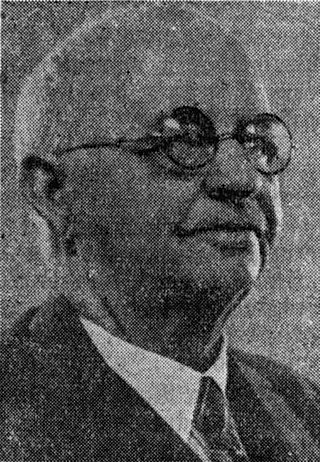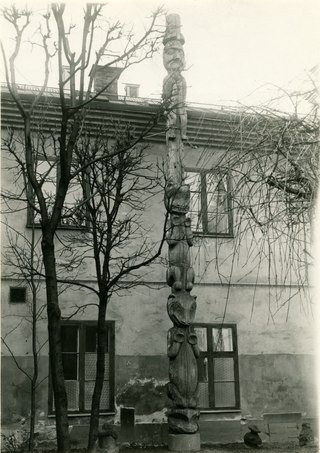
Totem poles are monumental carvings found in western Canada and the northwestern United States. They are a type of Northwest Coast art, consisting of poles, posts or pillars, carved with symbols or figures. They are usually made from large trees, mostly western red cedar, by First Nations and Indigenous peoples of the Pacific Northwest Coast including northern Northwest Coast Haida, Tlingit, and Tsimshian communities in Southeast Alaska and British Columbia, Kwakwaka'wakw and Nuu-chah-nulth communities in southern British Columbia, and the Coast Salish communities in Washington and British Columbia.

The Museum of Anthropology at the University of British Columbia (UBC) campus in Vancouver, British Columbia, Canada displays world arts and cultures, in particular works by First Nations of the Pacific Northwest. As well as being a major tourist destination, MOA is a research and teaching museum, where UBC courses in art, anthropology, archaeology, conservation, and museum studies are given. MOA houses close to 50,000 ethnographic objects, as well as 535,000 archaeological objects in its building alone.

Sven Anders Hedin, KNO1kl RVO, was a Swedish geographer, topographer, explorer, photographer, travel writer and illustrator of his own works. During four expeditions to Central Asia, he made the Transhimalaya known in the West and located sources of the Brahmaputra, Indus and Sutlej Rivers. He also mapped lake Lop Nur, and the remains of cities, grave sites and the Great Wall of China in the deserts of the Tarim Basin. In his book Från pol till pol, Hedin describes a journey through Asia and Europe between the late 1880s and the early 1900s. While traveling, Hedin visited Turkey, the Caucasus, Tehran, Iraq, lands of the Kyrgyz people and the Russian Far East, India, China and Japan. The posthumous publication of his Central Asia Atlas marked the conclusion of his life's work.

The Swedish History Museum is a museum located in Stockholm, Sweden, that covers Swedish archaeology and cultural history from the Mesolithic period to present day. Founded in 1866, it operates as a government agency and is tasked with preserving Swedish historical items as well as making knowledge about history available to the public.

Artur Immanuel Hazelius was a Swedish teacher, scholar, folklorist and museum director. He was the founder of both the Nordic Museum and the Skansen open-air museum in Stockholm.

Haisla people are a First Nation who reside in Kitamaat. The Haisla consist of two bands: the Kitamaat people, residing in upper Douglas Channel and Devastation Channel, and the Kitlope People, inhabiting upper Princess Royal Channel and Gardner Canal in British Columbia, Canada.

The Nordic Museum is a museum located on Djurgården, an island in central Stockholm, Sweden, dedicated to the cultural history and ethnography of Sweden from the early modern period to the contemporary period. The museum was founded in the late 19th century by Artur Hazelius, who also founded the open-air museum Skansen. It was, for a long time, part of the museum, until the institutions were made independent of each other in 1963.

Kulturen is an open-air museum as well as a museum of cultural history in Lund, Sweden. Occupying two blocks in central Lund, Kulturen is Sweden's and the world's second oldest open-air museum after Skansen in Stockholm. It contains historic buildings, dating from the Middle Ages to the 1930s, set in gardens or cobblestone streets. The museum displays around 20 exhibitions with themes ranging from medieval archaeology to 20th century fashion. The museum collections include art and design, archaeology, photography, crafts, and ethnography. The Museum is managed by Kulturhistoriska föreningen för södra Sverige.

Djurgårdsbrunnsviken is a bay in central Stockholm, Sweden, together with the canal Djurgårdsbrunnskanalen forming the northern shore line of the island Djurgården. The bridge Djurgårdsbron stretches over the bay.

The Putuo Zongcheng Temple of Chengde, Hebei province, China is a Qing dynasty era Buddhist temple complex built between 1767 and 1771, during the reign of the Qianlong Emperor (1735–1796). It is located near the Chengde Mountain Resort, which is south of the Putuo Zongcheng. Along with the equally famed Puning Temple, it is one of the Eight Outer Temples of Chengde. The temple was modeled after the Potala Palace of Tibet, the residence of the Dalai Lama built a century earlier. Since it was modeled after the Potala palace, the temple represents a fusion of Chinese and Tibetan architectural styles. The temple complex covers a surface area of some 220,000 square metres (2,400,000 sq ft), making it one of the largest in China. Many of its halls and pavilions are adorned with copper and gold tiled roofs, adding to the splendor of the site.

The Museum of Far Eastern Antiquities, located in Stockholm, Sweden, is a museum launched by Sweden's Parliament in 1926, with the Swedish archaeologist Johan Gunnar Andersson (1874–1960) as founding director. The museum is located on Skeppsholmen in the building Tyghuset and since 1999 the museum is a part of the public Swedish National Museums of World Culture.

Folke Bergman was a Swedish explorer and archaeologist.

Knut Hjalmar Stolpe, was a Swedish entomologist, archaeologist, and ethnographer. He was the first director and curator of the Museum of Ethnography, Sweden. He is best known for his meticulous archaeological excavations at the Viking-age site Birka on the island Björkö.

Fadno is a reed instrument and domestic flute of the Sami people of Scandinavia, made from Angelica archangelica. The instrument features a reed and three to six fingerholes and appears to have no parallels among the surrounding Scandinavian peoples.
The Swedish Centre for Architecture and Design or ArkDes, previously known as the Museum of Architecture (Arkitekturmuseet), is a Swedish national museum dedicated to architecture and design. It is located on the island of Skeppsholmen in Stockholm, Sweden, in the same complex as Moderna Museet. The museum exhibits architecture, urban planning and design under its current director Kieran Long. It is an administrative authority under the Ministry of Culture.
Karl Gösta Montell (1899–1975) was a Swedish ethnographer.

Maximilian Franz Thiel, often just called Max Thiel, was a German agent who worked for Hernsheim & Co in German New Guinea. He was manager of the Pacific operations of the German enterprise. His mother Rosetta Albertina was sister to Eduard and Franz Hernsheim, the founders of Hernsheim & Co. In at least 1884 he was living on Jaluit, Marshall Islands, at the same time as Franz Hernsheim. The year after he got to German New Guinea where he lived in Matupi in Rabaul, Niu Briten, Bismarck Archipelago where also Eduard Hernsheim lived. Here he was manager as well as part-time owner of Hernsheim & Co. During this time he was also Norwegian consul in German New Guinea.

The Gʼpsgolox totem pole was a nine-metre-high mortuary pole that was made in 1872 by the Haisla people on the shore of Douglas Channel in British Columbia, Canada. In 1929 it was brought to Sweden and the Museum of Ethnography. In 2006 it was returned to the Haisla people. In 2012 it was allowed to decompose, in accordance with the Haisla tradition for long-serving poles.

Zui-Ki-Tei is a free standing Japanese tea ceremony house that can be found in the park outside of the Museum of Ethnography in Stockholm, Sweden. It was built in Japan before being shipped to Sweden and erected in the park in 1990.
Barry Wilson is a Haisla artist from British Columbia who specialises in carving and jewellery.


















